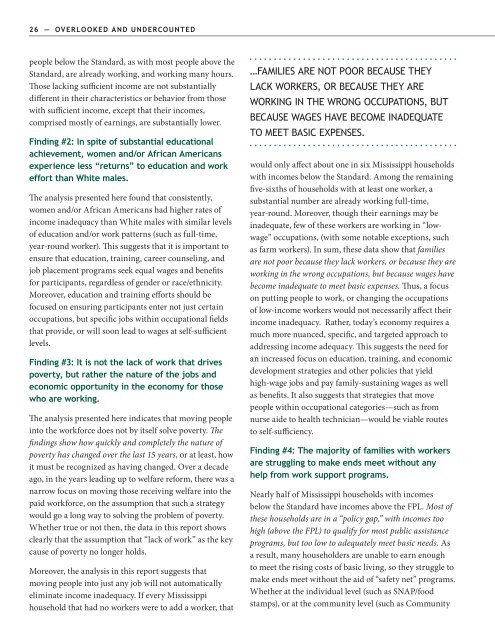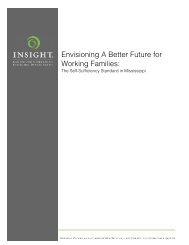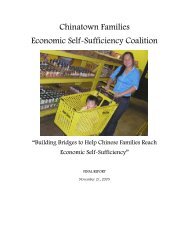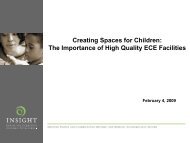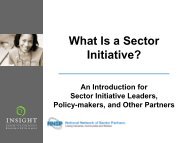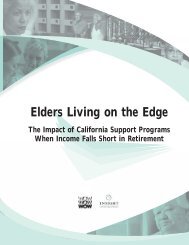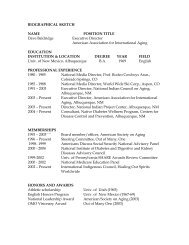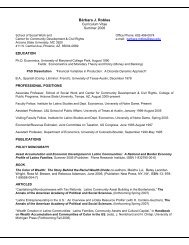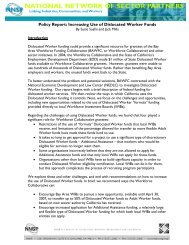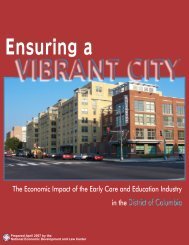Overlooked and Undercounted - Insight Center for Community ...
Overlooked and Undercounted - Insight Center for Community ...
Overlooked and Undercounted - Insight Center for Community ...
You also want an ePaper? Increase the reach of your titles
YUMPU automatically turns print PDFs into web optimized ePapers that Google loves.
26 — OVERLOOKED AND UNDERCOUNTED<br />
people below the St<strong>and</strong>ard, as with most people above the<br />
St<strong>and</strong>ard, are already working, <strong>and</strong> working many hours.<br />
Those lacking sufficient income are not substantially<br />
different in their characteristics or behavior from those<br />
with sufficient income, except that their incomes,<br />
comprised mostly of earnings, are substantially lower.<br />
Finding #2: In spite of substantial educational<br />
achievement, women <strong>and</strong>/or African Americans<br />
experience less “returns” to education <strong>and</strong> work<br />
ef<strong>for</strong>t than White males.<br />
The analysis presented here found that consistently,<br />
women <strong>and</strong>/or African Americans had higher rates of<br />
income inadequacy than White males with similar levels<br />
of education <strong>and</strong>/or work patterns (such as full-time,<br />
year-round worker). This suggests that it is important to<br />
ensure that education, training, career counseling, <strong>and</strong><br />
job placement programs seek equal wages <strong>and</strong> benefits<br />
<strong>for</strong> participants, regardless of gender or race/ethnicity.<br />
Moreover, education <strong>and</strong> training ef<strong>for</strong>ts should be<br />
focused on ensuring participants enter not just certain<br />
occupations, but specific jobs within occupational fields<br />
that provide, or will soon lead to wages at self-sufficient<br />
levels.<br />
Finding #3: It is not the lack of work that drives<br />
poverty, but rather the nature of the jobs <strong>and</strong><br />
economic opportunity in the economy <strong>for</strong> those<br />
who are working.<br />
The analysis presented here indicates that moving people<br />
into the work<strong>for</strong>ce does not by itself solve poverty. The<br />
findings show how quickly <strong>and</strong> completely the nature of<br />
poverty has changed over the last 15 years, or at least, how<br />
it must be recognized as having changed. Over a decade<br />
ago, in the years leading up to welfare re<strong>for</strong>m, there was a<br />
narrow focus on moving those receiving welfare into the<br />
paid work<strong>for</strong>ce, on the assumption that such a strategy<br />
would go a long way to solving the problem of poverty.<br />
Whether true or not then, the data in this report shows<br />
clearly that the assumption that “lack of work” as the key<br />
cause of poverty no longer holds.<br />
Moreover, the analysis in this report suggests that<br />
moving people into just any job will not automatically<br />
eliminate income inadequacy. If every Mississippi<br />
household that had no workers were to add a worker, that<br />
…FAMILIES ARE NOT POOR BECAUSE THEY<br />
LACK WORKERS, OR BECAUSE THEY ARE<br />
WORKING IN THE WRONG OCCUPATIONS, BUT<br />
BECAUSE WAGES HAVE BECOME INADEQUATE<br />
TO MEET BASIC EXPENSES.<br />
would only affect about one in six Mississippi households<br />
with incomes below the St<strong>and</strong>ard. Among the remaining<br />
five-sixths of households with at least one worker, a<br />
substantial number are already working full-time,<br />
year-round. Moreover, though their earnings may be<br />
inadequate, few of these workers are working in “lowwage”<br />
occupations, (with some notable exceptions, such<br />
as farm workers). In sum, these data show that families<br />
are not poor because they lack workers, or because they are<br />
working in the wrong occupations, but because wages have<br />
become inadequate to meet basic expenses. Thus, a focus<br />
on putting people to work, or changing the occupations<br />
of low-income workers would not necessarily affect their<br />
income inadequacy. Rather, today’s economy requires a<br />
much more nuanced, specific, <strong>and</strong> targeted approach to<br />
addressing income adequacy. This suggests the need <strong>for</strong><br />
an increased focus on education, training, <strong>and</strong> economic<br />
development strategies <strong>and</strong> other policies that yield<br />
high-wage jobs <strong>and</strong> pay family-sustaining wages as well<br />
as benefits. It also suggests that strategies that move<br />
people within occupational categories—such as from<br />
nurse aide to health technician—would be viable routes<br />
to self-sufficiency.<br />
Finding #4: The majority of families with workers<br />
are struggling to make ends meet without any<br />
help from work support programs.<br />
Nearly half of Mississippi households with incomes<br />
below the St<strong>and</strong>ard have incomes above the FPL. Most of<br />
these households are in a “policy gap,” with incomes too<br />
high (above the FPL) to qualify <strong>for</strong> most public assistance<br />
programs, but too low to adequately meet basic needs. As<br />
a result, many householders are unable to earn enough<br />
to meet the rising costs of basic living, so they struggle to<br />
make ends meet without the aid of “safety net” programs.<br />
Whether at the individual level (such as SNAP/food<br />
stamps), or at the community level (such as <strong>Community</strong>


